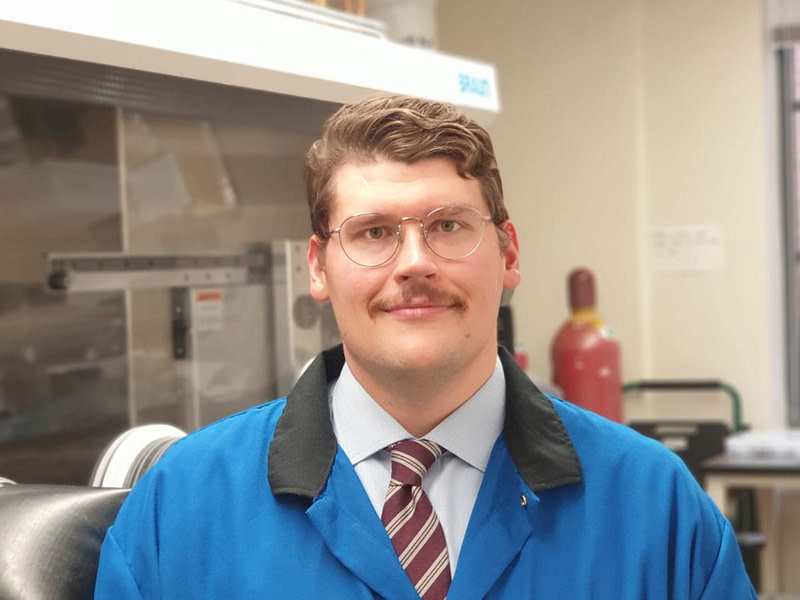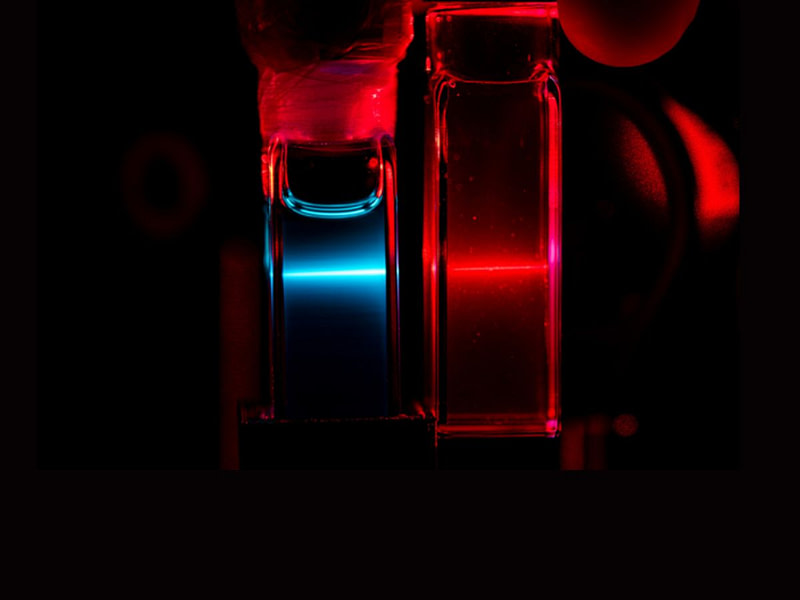Teksti Jussi Isokuortti, pääkuva Cristina Palma
I believe chemists have only begun to uncover the full potential of light. Researchers at the University of Texas at Austin are at the forefront of this revolution – whether it is improving solar cells or creating new light-driven reaction. Is it the hot Texas sun that fuels their drive?

Let me start by asking a different question: What do the processor in your smartphone and the latest model of Adidas 4DFWD sneakers have in common? Both rely on the precise use of light during their manufacturing.
However, the light-based processes involved in their manufacturing are polar opposites. In microchip fabrication, UV light is used to etch microscopic shapes in the photoresist.
This process is called photolithography, and in a way, it resembles the traditional methods of subtractive manufacturing, such as turning, drilling and cutting, used to make steam engines and the Ford Model T.
On the other hand, the sneaker sole is produced by adding material layer-by-layer, with light used to control the process spatially. This technique is known as light-based 3D printing, a form of additive manufacturing.
1 + 1 = Greater Precision and New Applications?
I am a physical chemist, who studied light-driven processes from a fundamental perspective in my doctorate. However, my “teekkari” (Finnish university engineering student) heritage has always made me curious about the possible applications of light.
Thus, I decided to try and do my postdoctorate in applied research and jumped at the chance to work in a National Science Foundation funded project, led by professors Sean Roberts and Zachariah Page at the University of Texas at Austin. Our goal: harnessing photon upconversion in 3D printing.
Photon upconversion is a process where the energy of low energy photons are combined to produce a single, higher-energy photon.
During my doctoral research, I studied triplet-triplet annihilation (TTA, also known as triplet fusion), which is capable of driving photon upconversion. In TTA, the energy of the low energy photons is stored in metastable triplet states that can annihilate and generate higher-energy excited states.
Although TTA was discovered in the 1960s, it remained something of a photochemical curiosity, until it resurfaced again in the 2000s as a potential way of boosting solar cells efficiency by upconverting the sub-bandgap photons to photons that the solar cell can absorb.
Since then, TTA has been applied across various fields ranging from bioimaging and drug release systems to photoredox catalysis in organic synthesis. Most recently, it has found use in photopolymerizations and additive manufacturing.

”A result is a finer resolution and a broader palette of materials for 3D printing.”
So, why are we eager to implement this somewhat exotic process of photon upconversion in 3D printing?
Today, most photopolymerizations, i.e. curing resins with light, are performed using UV light. For example, you may have noticed this if you have been to the dentist recently. The short-wavelength photons of UV light provide high enough energy to directly cleave bonds and thus create radicals that can initiate the polymerization reaction. UV-curable resins are industry standards, thanks to their speed and reliability.
However, relying on harsh UV light has its drawbacks. However, the same high-energy nature that makes UV light effective also makes it harmful. It limits the materials that can be safely incorporated into resins and reduces the depth and resolution of prints due to light scattering.
Enter photon upconversion, which allows us to generate these high-energy photons precisely where and when they are needed. This results in a finer resolution and opens up a broader palette of materials for 3D printing.
Early proof-of-concept studies on using photon upconversion in 3D printing leveraged high-intensity laser excitation and strictly oxygen-free conditions. Our team decided to push the envelope of TTA-based upconversion by applying it in digital light processing (DLP) printing, where the excitation source is a low-intensity LED, and under ambient conditions. This would make the technology more accessible as DLP printers are commercially available, easy to operate and no purging of the resin is required prior to printing.
”We are pursuing a US patent for our invention.”
These design parameters were ambitious, but our team of physical and polymer chemists was made to tackle this challenge. After a year of rigorous development and careful photosystem optimization, we created a resin that performs reliably under low-intensity green light excitation, even in the presence of oxygen.
Our results were published in 2024 in ACS Central Science, where the article is freely available. We are also pursuing a US patent for our invention that has attracted some interest from industry as well. The platform is tunable, and we are currently exploring its use in other types of light-based 3D printing methods beyond DLP.

”Folks are proud of their universities.”
Life and science in Texas
The Page and Roberts groups represent distinct fields of chemistry, allowing me to explore different projects ranging from developing new photosystems for polymer synthesis to designing organic and hybrid (i.e. combining both organic and inorganic materials) semiconductors.
This freedom stems from encouraging and supportive supervisors, the generous funding of the Finnish Academy of Science and Letters through the Post Doc Pool system, and the opportunities provided by the University of Texas.
Large institutions like UT Austin offer many advantages. Shared instrumentation facilities here often exceed what is available in smaller European countries.
Collaboration opportunities on both institutional and national level are plentiful. Weekly seminars hosted by the Department of Chemistry and the Texas Materials Institute bring in leading researchers from all around the U.S.
Folks are proud of their universities, which manifests in friendly competition and rivalries, such as UT Austin versus Oklahoma or Texas A&M. This is especially visible in (American) football that permeates life on every level in Texas. The campus atmosphere is electrifying during the football season!
”The campus atmosphere is electrifying during the football season.”

Overall, I expected a bigger culture shock when I moved to Texas. Although I am still not used to telling how my day is going when I order a cup of coffee, the real shock, unsurprisingly, has been the climate. I thought I was mentally prepared for it, but I guess it is impossible to brace for the Texas heat.
Otherwise, my life in Texas looks and feels very similar to my life in Finland. Admittedly, I live in an academic bubble. All my friends are my colleagues, my neighbors are highly educated and many of them even work at the university. Nevertheless, I am surprised how easy it was to become a part of a community.
Working in the US has been a rewarding journey. I am grateful for this opportunity and glad I seized it at this point in my career. Not only have I become a better chemist and scientist, but I have also gained confidence in my abilities and skills to conduct research anywhere.
Most importantly, it is the people I have met and worked with who have made this experience truly meaningful. I am curious and ready to see where the light leads me next.
Lue myös: Gust.Kompan palkinnolla kaksi voittajaa 2023 – Tuntuu kirsikalta kakun päällä


